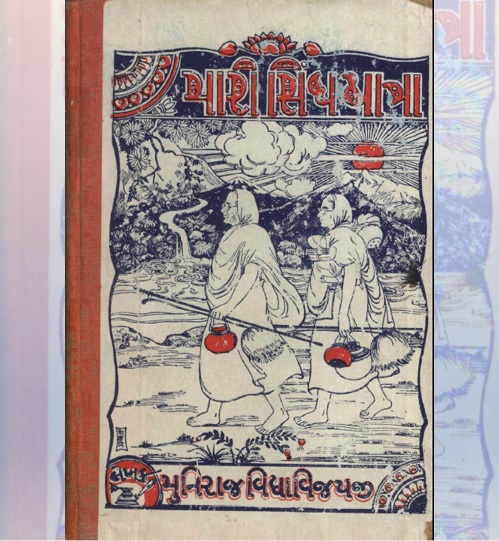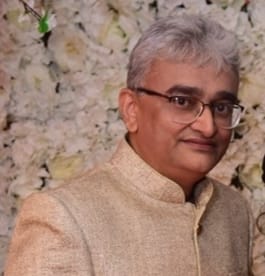
There are two types of the Sindhi language – ‘Farsi Sindhi’ and ‘Vaniya Sindhi’. Sindhi Hindus use both these languages. Both languages are the same in verbal communication while they differ in their script
[Editor’s Note: This is Part 21 (Sindhi Hindus – Part 2) of a series of articles based on a pre-partition book named “મારી સિંધ યાત્રા” (“منهنجي سنڌ جو سفر”) in Gujarati authored by a scholarly Jain sadhu Shri Vidyavijayji, narrating his experiences of Journey and his Stay in Karachi for about 2 and a half years between 1937 and 1939. It would be advisable to click on the Introductory Article and read it to better understand the series. – Nasir Aijaz, Editor Sindh Courier]
Vimal Shah, Mumbai
Language and Script
There are two types of the Sindhi language – ‘Farsi Sindhi’ and ‘Vaniya Sindhi’. Sindhi Hindus use both these languages. Both languages are the same in verbal communication while they differ in their script. Aamils mostly use Farsi Sindhi. Alphabets like Persian and writing from right to left. There are some differences between this Farsi Sindhi and Urdu script. Urdu script has 29 alphabets while Sindhi has 52. Bhaibands, who are generally businessmen mostly use ‘Vania Sindhi’. Some people call it ‘Bhaiband Script’ while others ‘Hatai’. It’s a script without long vowels and written from left to right.
Bhaiband community people are mostly businessmen and many of them who are dealing with Gujaratis of Karachi use Gujarati in their communication very well. They can’t read or write Farsi Sindhi.
To date, the script of ‘Businessmen’s Sindhi’ can be said to be a descendant of Sanskrit and Prakrit. But during the Muslim rule ‘Arabi’ was adopted as Sindhi script which has continued till today
Not much literature has been created in the Sindhi language. It is said that Shah Abdul Latif was a literary scholar of Sindhi literature in Farsi script. He has novels, poetic compositions, and philosophical literature to his credit. Kavi Meghraj is popular for his creations in Vaniya script.
You find abundant Sufism among their literature. Popular scholar and literary writer Shri Dungarsi Dharamsi Sampat opines that:
“Original Sindhi language was derived from Sanskrit. Its script also must have been Sanskrit at the time. To date, the script of ‘Businessmen’s Sindhi’ can be said to be a descendant of Sanskrit and Prakrit. But during the Muslim rule ‘Arbi’ (Arabic) was adopted as Sindhi script which has continued till today. Most of the words of the Sindhi language originate from Sanskrit but later many words have been adopted from Farsi (Persian) and Arbi. It has remained poor because adequate efforts have not been spent on enriching the language on account of repeated meteorites of revolts. There do not seem to be any good dictionary or grammar book available.”
Religion
There’s no unified religion seen amongst Sindhi Hindus, and the reason is evident that their lineage has been under Muslim rulers for hundreds of years. Leave aside those who converted to Islam. Those who did not, are proud Hindus despite adopting Muslim culture in their customs and food habits.
There’s no unified religion seen amongst Sindhi Hindus. Generally speaking, they are not fanatic to any religion
You find their inclination towards Sikhism because Punjab and Sindh used to be a unified region during a certain period, and many Hindus of today have migrated from Punjab. Many Hindus have constructed Sikh shrines, they call them ‘Tikana’. Many keep ‘Guru Granth Sahib’ very respectfully in their home and worship them with devotedness. Thus, despite respecting Sikhism, they do not wear the five K’s – Kada, Kanga, Kirpan, Kesh, and Kachhera, the signs of Sikhs. Except for Aamils, many people are seen following different sects of Hinduism. All over Sindh, most people worship ‘Dariyalal Dev’. ‘Dariyalal’ is a deity of Oceans.
Generally speaking, they are not fanatic to any religion.
Clothing and Fashion
Clothing of both the communities is almost the same. Coat, Patloon, Necktie, Collar – this English clothing is adopted by men. And the women have adopted the latest fashion of Parsi, Bengali or English people.
The ladies generally wear a Pyjama while at home, it is also called a Patloon. Some ladies even venture out with their Pyjama
You will never find a man of the Aamil community in a Dhoti. You can find Shikarpuris and other people from the Bhaiband community in traditional wear, particularly the ones engaged in Business. The ladies generally wear a Pyjama while at home, it is also called a Patloon. Some ladies even venture out with their Pyjama.
At this time there’s no respect for the ‘Swadeshi Movement’ among this community. You mostly find a foreign influence on men and women. Modern educated or studying girls hardly don anything other than silk wear. And they don’t stick to any single fashion when it comes to Sarees. Different Sarees and different fashions from time to time. They wear accessories and makeup matching their clothing which can neither be described nor advisable for people like us.
It is said that about twenty-five years ago these Sindhi Hindu women used to wear Parda that would beat the oldest Parda tradition of Marwad. No one could see even the fingers of the hands and legs of the women. The entire body would be covered from head to toe. They used to see through the net over their eyes or with just one eye by slightly lifting the Parda with one finger. They would wear a large round ‘Nath’ (nose ring) and tie the ‘Nath’ with a tuft of hair. These days you find a few elderly women as a specimen of this tradition. Essentially, the latest fashions have penetrated this community. Some elderly women shed tears seeing the new-age fashions with their mature eyes. According to those elderly mothers, today’s fashions are like meteorites.
I feel the Sindhi women were confined to the dark for hundreds of years due to the atrocities of the Muslims
There must be strong reasons for the transformation and influence of so much fashion within a timespan of just twenty to twenty-five years. I feel the Sindhi women were confined to the dark for hundreds of years due to the atrocities of the Muslims. They had not seen even a ray of light from the outside world. When they got rid of the confinement, they escaped out of hand.
On the other hand, education became popular among the women just like men of this community. They got access to schools and colleges. In this community, particularly Aamil women, modern education is so popular that there would be hardly any family in which one or two girls are not graduate or undergraduate. The women of this community have advanced so much in the field of education that you would seldom find in any other community. They were already wealthy, and they also got an opportunity of mingling with other communities. For these reasons, they got influenced by fashion, rather limitless fashion. When a man gets rid of a long period of confinement, he celebrates liberation like anything. That’s what happened with the Sindhi women.
Modern education is so popular that there would be hardly any family in which one or two girls are not graduate or undergraduate
Many fear that this limitless fashion would drop the entire community in ditches beyond imagination. One of my friends had told me – Parsi women have advanced in their fashion, but the good thing is that they are cultured, religious, and compassionate. They would visit ‘Agiyari’ – their place of worship, pray and seek blessings from God. Due to their generousness, they would donate some money, rather affluent Parsi women donate to big charities. Their fashion would change tomorrow if not today. They would understand at any point in time. Whereas the Aamil community is not so religious. You hardly find any aim of life other than eat–drink–and marry among their women. In addition, they do not live under the command of any Dharma Guru. Therefore, you can’t predict the destiny of this community.
Despite many people opining like above, I believe time would do the justice. Anything that grows abundantly always gets back to its originality. The number of women among them would not be less, rather it’s not less who prefer to live a modest and spiritual life, and you can also see good religious rites in them. (Continues)
Click here for Part-I, Part-II, Part-III, Part-IV, Part-V , Part-VI , Part-VII , Part-VIII , Part-IX, Part-X, Part-XI, Part-XII, Part-XIII , Part-XIV, Part-XV, Part-XVI , Part-XVII, Part-XVIII , Part-XIX, Part-XX
________________
About the contributor of the series of Articles based on the book
 Vimal Shah is a follower of Jainism by birth and is based in Mumbai, India. He is a Computer Engineer and holds a Diploma in Jainology from Mumbai University. He has an immense interest in reading, writing, studying, and teaching Jain Philosophical subjects. He conducts classroom as well as online sessions on Jain Philosophical courses. He continues to study various subjects and remains a student of Jain Philosophy. He has significantly contributed to the Translation Project of the ‘Compendium of Jainism’ from English to Gujarati – an initiative of the JAINA India Foundation. He is also associated with a Project for the translation of Jain Aagams (Scriptures) from Gujarati to English. He has a special interest in the history and preservation of the Jain Heritage in Pakistan. He was part of a Delegation of the Jain Heritage Foundation, New Delhi that visited various Jain Heritage Sites in Pakistan in May-2023.
Vimal Shah is a follower of Jainism by birth and is based in Mumbai, India. He is a Computer Engineer and holds a Diploma in Jainology from Mumbai University. He has an immense interest in reading, writing, studying, and teaching Jain Philosophical subjects. He conducts classroom as well as online sessions on Jain Philosophical courses. He continues to study various subjects and remains a student of Jain Philosophy. He has significantly contributed to the Translation Project of the ‘Compendium of Jainism’ from English to Gujarati – an initiative of the JAINA India Foundation. He is also associated with a Project for the translation of Jain Aagams (Scriptures) from Gujarati to English. He has a special interest in the history and preservation of the Jain Heritage in Pakistan. He was part of a Delegation of the Jain Heritage Foundation, New Delhi that visited various Jain Heritage Sites in Pakistan in May-2023.